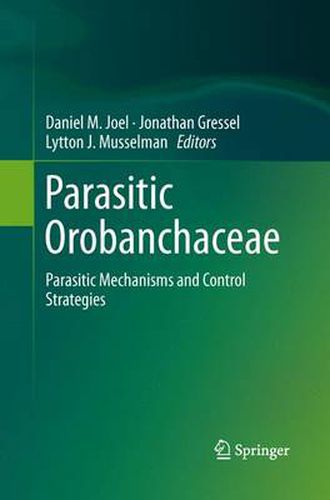Readings Newsletter
Become a Readings Member to make your shopping experience even easier.
Sign in or sign up for free!
You’re not far away from qualifying for FREE standard shipping within Australia
You’ve qualified for FREE standard shipping within Australia
The cart is loading…






This title is printed to order. This book may have been self-published. If so, we cannot guarantee the quality of the content. In the main most books will have gone through the editing process however some may not. We therefore suggest that you be aware of this before ordering this book. If in doubt check either the author or publisher’s details as we are unable to accept any returns unless they are faulty. Please contact us if you have any questions.
This book was written in response to significant recent advances in understanding the mechanisms of parasitism in the Orobanchaceae, and breakthroughs in the control of the parasitic weeds Striga and Orobanche. It consists of 26 contributions by internationally recognized leading scientists. The main book chapters are grouped into two parts:
*
Part I - The Orobanchaceae and Their Parasitic Mechanisms
*
Part II - The Weedy Orobanchaceae and Their Control
The first part provides cutting-edge information on all key aspects of plant parasitism, such as the structure, development and function of the haustorium; nutrient transfer and the physiology of the parasite-host association; host reaction to parasitic plants; seed production and germination; the strigolactones and host-parasite signaling mechanisms; the parasite genome, phylogenetics, evolution and epigenetics; and ecology. Topics of the second part include: the problem posed by the weedy parasites; population diversity and dynamics; molecular diagnosis of seed banks; and detailed discussion of the various management strategies, including agronomic, chemical and biotechnological approaches, as well as host breeding for resistance, allelopathy and biological control.
This book is intended for plant scientists, university lecturers and students, agronomists and weed specialists, breeders and farmers, extension personnel and experts in tropical and subtropical agriculture.
$9.00 standard shipping within Australia
FREE standard shipping within Australia for orders over $100.00
Express & International shipping calculated at checkout
This title is printed to order. This book may have been self-published. If so, we cannot guarantee the quality of the content. In the main most books will have gone through the editing process however some may not. We therefore suggest that you be aware of this before ordering this book. If in doubt check either the author or publisher’s details as we are unable to accept any returns unless they are faulty. Please contact us if you have any questions.
This book was written in response to significant recent advances in understanding the mechanisms of parasitism in the Orobanchaceae, and breakthroughs in the control of the parasitic weeds Striga and Orobanche. It consists of 26 contributions by internationally recognized leading scientists. The main book chapters are grouped into two parts:
*
Part I - The Orobanchaceae and Their Parasitic Mechanisms
*
Part II - The Weedy Orobanchaceae and Their Control
The first part provides cutting-edge information on all key aspects of plant parasitism, such as the structure, development and function of the haustorium; nutrient transfer and the physiology of the parasite-host association; host reaction to parasitic plants; seed production and germination; the strigolactones and host-parasite signaling mechanisms; the parasite genome, phylogenetics, evolution and epigenetics; and ecology. Topics of the second part include: the problem posed by the weedy parasites; population diversity and dynamics; molecular diagnosis of seed banks; and detailed discussion of the various management strategies, including agronomic, chemical and biotechnological approaches, as well as host breeding for resistance, allelopathy and biological control.
This book is intended for plant scientists, university lecturers and students, agronomists and weed specialists, breeders and farmers, extension personnel and experts in tropical and subtropical agriculture.